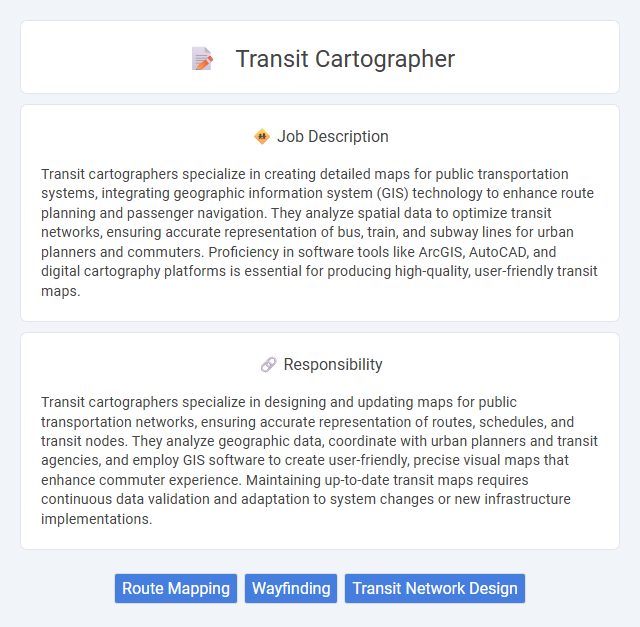
Transit cartographers specialize in creating detailed maps for public transportation systems, integrating geographic information system (GIS) technology to enhance route planning and passenger navigation. They analyze spatial data to optimize transit networks, ensuring accurate representation of bus, train, and subway lines for urban planners and commuters. Proficiency in software tools like ArcGIS, AutoCAD, and digital cartography platforms is essential for producing high-quality, user-friendly transit maps.
Individuals with strong spatial awareness and a keen interest in maps are likely to suit the transit cartographer role. Those who enjoy detailed, repetitive tasks and working with geographic information systems (GIS) may find this job fitting and fulfilling. However, people who struggle with technology or lack patience for precision might find the position challenging.
Qualification
A Transit Cartographer must possess strong skills in Geographic Information Systems (GIS), spatial analysis, and data visualization to create accurate and functional transit maps. Proficiency in software such as ArcGIS, QGIS, and Adobe Illustrator is essential for designing detailed transport networks. A background in urban planning, geography, or cartography, combined with experience in public transportation systems, enhances the ability to interpret and present transit data effectively.
Responsibility
Transit cartographers specialize in designing and updating maps for public transportation networks, ensuring accurate representation of routes, schedules, and transit nodes. They analyze geographic data, coordinate with urban planners and transit agencies, and employ GIS software to create user-friendly, precise visual maps that enhance commuter experience. Maintaining up-to-date transit maps requires continuous data validation and adaptation to system changes or new infrastructure implementations.
Benefit
A transit cartographer likely benefits from opportunities to work with cutting-edge geospatial technologies, enhancing their technical skills and expertise. The role probably offers a collaborative environment where professionals contribute to urban planning and transportation development, increasing job satisfaction. Competitive salaries and the potential for career advancement in public infrastructure projects might also be common advantages.
Challenge
Transit cartographers likely encounter challenges related to accurately mapping complex transportation networks that constantly evolve. Integrating real-time data from various sources may present difficulties in ensuring maps stay current and reliable. Balancing detail and clarity to create user-friendly transit maps could often require innovative problem-solving skills.
Career Advancement
Transit cartographers specializing in urban transportation systems have strong career advancement opportunities due to the increasing demand for smart city infrastructure and detailed transit mapping. Mastery of Geographic Information Systems (GIS) and data visualization tools enhances prospects for promotion to senior cartographer or transit planner roles. Professionals often transition into leadership positions overseeing transit project design and implementation within municipal or private sector transportation agencies.
Key Terms
Route Mapping
Transit cartographers specialize in creating accurate route maps for public transportation systems, using geographic information systems (GIS) and spatial analysis tools to design efficient transit routes. Their work involves integrating real-time data and passenger flow analytics to optimize connectivity and minimize travel times. Proficiency in data visualization and urban planning principles ensures transit maps enhance user navigation and system accessibility.
Wayfinding
Transit cartographers specialize in creating detailed, user-friendly maps that enhance wayfinding for public transportation systems. They utilize geographic information systems (GIS) and spatial data analysis to design intuitive routes, signage, and navigation aids that improve passenger experience and reduce travel confusion. Their work supports urban mobility by ensuring accurate, accessible transit information across multiple platforms and devices.
Transit Network Design
Transit cartographers specializing in transit network design analyze urban mobility patterns and geographic data to create efficient routes and service maps. They utilize GIS technology and spatial analysis to optimize transit coverage, reduce travel times, and enhance rider accessibility. Their expertise supports public transportation agencies in improving system connectivity and operational planning.
 kuljobs.com
kuljobs.com